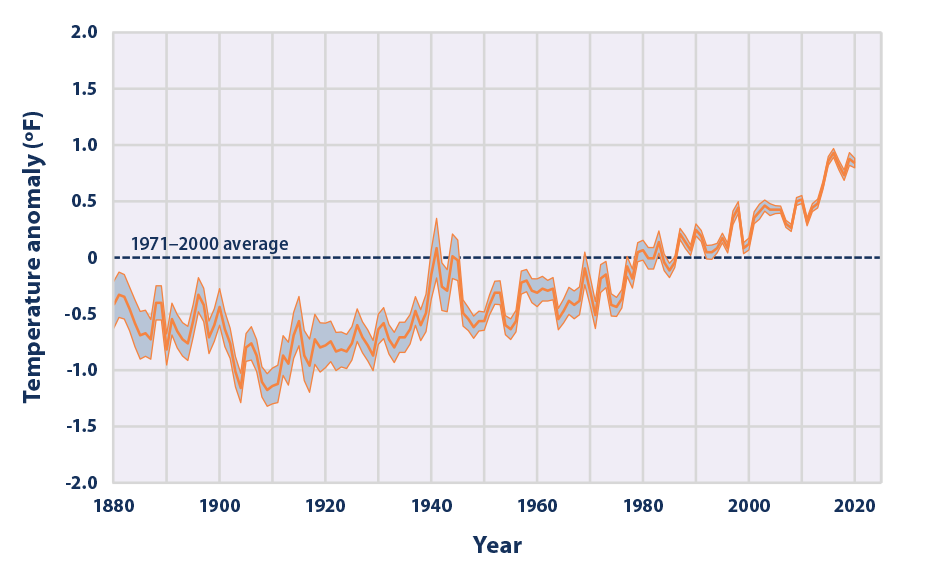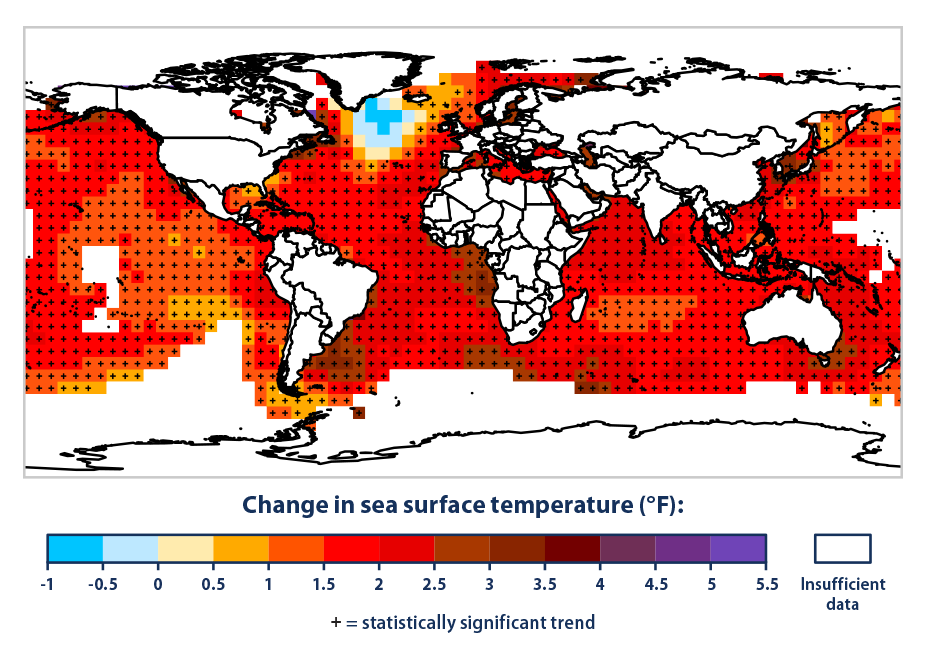Explain How the Earthã¢â‚¬â„¢s Surface Can Change as a Result of Global Warming.
This indicator describes global trends in sea surface temperature.
-



This graph shows how the average surface temperature of the world's oceans has inverse since 1880. This graph uses the 1971 to 2000 average as a baseline for depicting change. Choosing a unlike baseline menses would non modify the shape of the information over time. The shaded band shows the range of uncertainty in the information, based on the number of measurements collected and the precision of the methods used.
Information source: NOAA, 20217
Web update: April 2021 -



This map shows how average sea surface temperature around the world changed betwixt 1901 and 2020. It is based on a combination of direct measurements and satellite measurements. A black "+" symbol in the heart of a square on the map means the tendency shown is statistically significant. White areas did not take plenty data to summate reliable long-term trends.
Data source: IPCC, 2013;viii NOAA, 20219
Web update: April 2021
Key Points
- Sea surface temperature increased during the 20th century and continues to rise. From 1901 through 2020, temperature rose at an average charge per unit of 0.fourteen°F per decade (see Figure 1).
- Ocean surface temperature has been consistently college during the by three decades than at any other fourth dimension since reliable observations began in 1880 (run across Figure ane).
- Based on the historical tape, increases in body of water surface temperature accept largely occurred over two primal periods: betwixt 1910 and 1940, and from about 1970 to the nowadays. Sea surface temperature appears to have cooled between 1880 and 1910 (meet Figure 1).
- Changes in sea surface temperature vary regionally. While most parts of the earth's oceans take seen temperature ascension, a few areas have actually experienced cooling—for case, parts of the N Atlantic (run across Figure 2).
Background
Ocean surface temperature—the temperature of the water at the ocean surface—is an important physical aspect of the world's oceans. The surface temperature of the world's oceans varies mainly with latitude, with the warmest waters mostly near the equator and the coldest waters in the Arctic and Antarctic regions. As the oceans absorb more than heat, body of water surface temperature increases, and the sea circulation patterns that transport warm and cold water effectually the globe alter.
Changes in sea surface temperature can alter marine ecosystems in several ways. For case, variations in ocean temperature can impact what species of plants, animals, and microbes are present in a location, alter migration and convenance patterns, threaten sensitive body of water life such as corals, and change the frequency and intensity of harmful algal blooms such every bit "red tide."one Over the long term, increases in ocean surface temperature could also reduce the circulation patterns that bring nutrients from the deep sea to surface waters. Changes in reef habitat and food supply could dramatically change ocean ecosystems and lead to declines in fish populations, which in turn could affect people who depend on fishing for food or jobs.2, 3
Because the oceans continuously collaborate with the atmosphere, sea surface temperature can also accept profound effects on global climate. Increases in sea surface temperature have led to an increase in the amount of atmospheric water vapor over the oceans.iv This water vapor feeds weather systems that produce precipitation, increasing the risk of heavy pelting and snowfall (see the Heavy Atmospheric precipitation and Tropical Cyclone Activity indicators). Changes in sea surface temperature can shift storm tracks, potentially contributing to droughts in some areas.v Increases in ocean surface temperature are too expected to lengthen the growth flavour for sure bacteria that can contaminate seafood and cause foodborne illnesses, thereby increasing the risk of health effects.6
Near the Indicator
This indicator tracks average global ocean surface temperature from 1880 through 2020. It likewise includes a map to testify how change in sea surface temperature has varied across the world's oceans since 1901.
Techniques for measuring sea surface temperature have evolved since the 1800s. For instance, the primeval data were nerveless by inserting a thermometer into a h2o sample collected past lowering a bucket from a send. Today, temperature measurements are collected more systematically from ships, equally well as at stationary and drifting buoys.
The National Oceanic and Atmospheric Administration has carefully reconstructed and filtered the data in Figure one to correct for biases in the different drove techniques and to minimize the effects of sampling changes over various locations and times. The data are shown equally anomalies, or differences, compared with the average sea surface temperature from 1971 to 2000. The map in Effigy 2 was originally developed by the Intergovernmental Panel on Climate Change, which calculated long-term trends based on a collection of published studies.
About the Information
Indicator Notes
Both components of this indicator are based on instrumental measurements of surface water temperature. Due to denser sampling and improvements in sampling design and measurement techniques, newer information are more precise than older information. The earlier trends shown by this indicator have less certainty because of lower sampling frequency and less precise sampling methods.
Data Sources
Data for Effigy 1 were provided by the National Oceanic and Atmospheric Administration's National Centers for Environmental Information and are available online at: www.ncdc.noaa.gov/data-access/marineocean-data/extended-reconstructed-sea-surface-temperature-ersst. These data were reconstructed from measurements of water temperature, which are available from the National Oceanic and Atmospheric Assistants at: https://icoads.noaa.gov/products.html. Figure ii is an updated version of a map that appeared in the Intergovernmental Console on Climate change'southward 5th Assessment Report (www.ipcc.ch/study/ar5/wg1), which gathered information from a diversity of studies that provide the best available information about climate change.
Technical Documentation
- Download related technical information PDF
References
1. For case, meet: Ostrander, G.K., Thou.M. Armstrong, Eastward.T. Knobbe, D. Gerace, and E.P. Scully. 2000. Rapid transition in the structure of a coral reef community: The effects of coral bleaching and physical disturbance. P. Natl. Acad. Sci. USA. 97(10):5297–5302.
2. Pratchett, M.S., South.Yard. Wilson, M.Fifty. Berumen, and M.I. McCormick. 2004. Sublethal effects of coral bleaching on an obligate coral feeding butterflyfish. Coral Reefs 23(three):352–356.
3. Pershing, A.J., R.B. Griffis, E.B. Jewett, C.T. Armstrong, J.F. Bruno, D.S. Busch, A.C. Haynie, S.A. Siedlecki, and D. Tommasi. 2018. Oceans and marine resource. In: Impacts, risks, and adaptation in the The states: 4th National Climate Assessment, volume Two. Reidmiller, D.R., C.W. Avery, D.R. Easterling, Thousand.E. Kunkel, Chiliad.L.K. Lewis, T.K. Maycock, and B.C. Stewart (eds.). doi:10.7930/NCA4.2018.CH9.
4. IPCC (Intergovernmental Panel on Climate Alter). 2013. Climate change 2013: The concrete scientific discipline basis. Working Group I contribution to the IPCC Fifth Cess Report. Cambridge, United Kingdom: Cambridge Academy Press. www.ipcc.ch/study/ar5/wg1.
v. IPCC (Intergovernmental Panel on Climate change). 2013. Climatic change 2013: The concrete scientific discipline basis. Working Group I contribution to the IPCC Fifth Cess Report. Cambridge, United Kingdom: Cambridge University Press. world wide web.ipcc.ch/report/ar5/wg1.
6. Trtanj, J., 50. Jantarasami, J. Brunkard, T. Collier, J. Jacobs, Due east. Lipp, S. McLellan, S. Moore, H. Paerl, J. Ravenscroft, Grand. Sengco, and J. Thurston. 2016. Chapter vi: Climate impacts on water-related disease. In: The impacts of climate change on homo health in the United States: A scientific assessment. U.Southward. Global Change Research Program. https://health2016.globalchange.gov.
7. NOAA (National Oceanic and Atmospheric Administration). 2021. Extended reconstructed bounding main surface temperature (ERSST.v5). National Centers for Ecology Information. Accessed Feb 2021. www.ncdc.noaa.gov/information-admission/marineocean-data/extended-reconstructed-sea-surface-temperature-ersst.
8. IPCC (Intergovernmental Panel on Climatic change). 2013. Climate modify 2013: The physical science basis. Working Group I contribution to the IPCC Fifth Cess Written report. Cambridge, Uk: Cambridge University Press. www.ipcc.ch/written report/ar5/wg1.
nine. NOAA (National Oceanic and Atmospheric Administration). 2021. NOAA Merged Land Body of water Global Surface Temperature Analysis (NOAAGlobalTemp). Accessed March 2021. www.ncdc.noaa.gov/information-access/marineocean-data/noaa-global-surface-temperature-noaaglobaltemp.
Source: https://www.epa.gov/climate-indicators/climate-change-indicators-sea-surface-temperature
0 Response to "Explain How the Earthã¢â‚¬â„¢s Surface Can Change as a Result of Global Warming."
Post a Comment